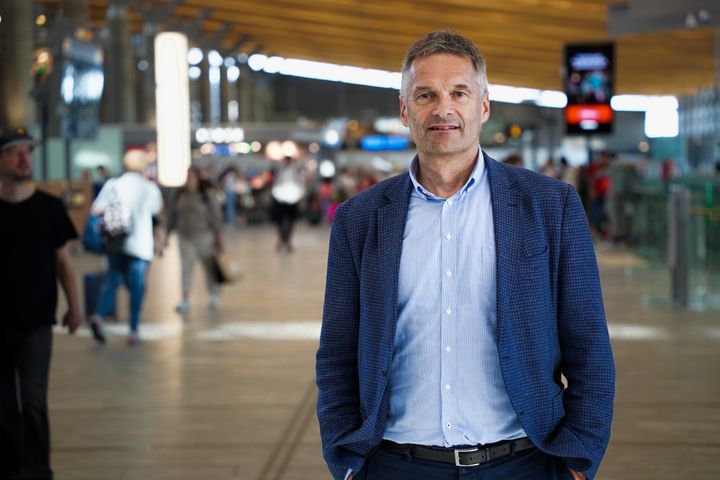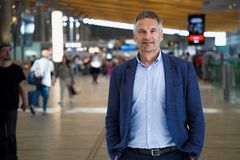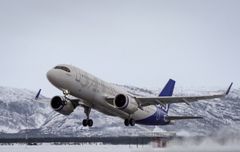Firsth quarter: Growth in air traffic

“The consequences of changing travel habits, uncertainty arising from the war in Ukraine, high rates of inflation and rising interest rates have all contributed to the fact that traffic has not returned to levels seen before the COVID-19 pandemic,” says Abraham Foss, CEO of Avinor.
Marked increase from 2022
Although air traffic has not returned to 2019 levels, the increase from the first quarter of 2022 is marked. This is largely due to the fact that the first quarter of 2022 was affected by the Omicron variant.
In the first quarter of 2023, the number of aircraft movements increased by 15 per cent compared with the corresponding period the year before. Domestic air transport movements increased by 11 per cent, while international air transport movements increased by 37 per cent.
“Traffic developments and travel patterns indicate that the strongest recovery was among holiday and leisure travellers. Business travellers remain below pre-pandemic levels, which is related to the fact that people are making more use of digital solutions to hold meetings than they did prior to the pandemic,” Foss explains.
The first quarter of 2023 was significantly affected by precipitation in the form of sleet and snow. This led to an increase in weather related delays. March was particularly affected by this, with a 223 per cent increase – three times higher – in weather related compared to 2022. The number of flight movements increased by 10 per cent during the same month.
Positive progress in major projects
The first three months of the year have been eventful for Avinor. The period has seen the airport towers at Svolvær, Sogndal and Førde transfer operations to the Remote Tower Centre in Bodø. Ground was officially broken on the new airport in Bodø in a ceremony involving the Minister of Transport and Communications, while later on that month he also cut the ribbon at the opening of the new terminal building at Tromsø Airport.
“It’s gratifying to see such progress in projects that are of such significance to Avinor. Development at Bodø is well underway and we have now broken ground, while we have also opened a new terminal at Tromsø Airport which will provide us with the appropriate capacity to handle the increasing influx of travellers to the region,” says Foss.
National Transport Plan
At the end of March, representations were made to the Ministry of Transport and the Ministry of Trade, Industry and Fisheries in which Avinor provided input on its priorities in the National Transport Plan (NTP) for the period 2025–2036.
“The Avinor model means that Avinor is a self-funding company that does not ordinarily receive grants via the government’s state budget. In the coming years, Avinor will work to make its operations increasingly efficient, safe and stable. We will continue to main and develop our 43 airports. Avinor must be an active driving force and facilitator or sustainability in aviation as a whole, and the company is not only investing in projects that promote fossil-free operations within the company but also supports initiatives to reduce other stakeholders’ emissions. The digitalisation of airspace – ‘Air Navigation Services of the Future’ – is a major technological project that will help to streamline air traffic navigation and reduce aviation-related emissions. Avinor is also keen to contribute to safe and efficient controls of the increasing number of drones found in Norwegian airspace. These are key elements of our representations to the ministries,” says Foss.
Challenging financial situation
Following up on the group’s financial position remains a priority area. The equity ratio as at 31 March 2023 calculated according to section 5 of the articles of association comprised 37.4 per cent. The group’s cash flow before changes in debt was NOK -496 million during the first quarter of 2023.
At an extraordinary general meeting held on 12 December 2022, the owner agreed to extend the temporary permission to deviate from the requirement set out in section 5 of the articles stipulating that the equity ratio must be at least 40 per cent until 31 December 2023. The minimum equity ratio for the period until this date has been set at 37 per cent. Avinor complies with all equity ratio requirements as regards external loans.
“Avinor remains in a very challenging financial situation and adjusting operations to reflect the volume of traffic is something that is weighed carefully against our operational costs. Our own project portfolio is also the subject of ongoing review and prioritisation efforts. We have many major projects on our plate, including the construction of two new airports in Mo i Rana and Bodø, as well as the implementation of new systems for en-route services, and these will account for much of Avinor’s financial capacity for several years to come. An extraordinarily strong increase in prices for building and construction projects represents an increased risk in Avinor’s project portfolio,” says Foss.
Major events during the first quarter of 2023
- As a result of the outbreak of war in Ukraine, Avinor is continuing to implement enhanced measures to secure its critical infrastructure. The war has also resulted in some reductions in traffic passing through Norwegian airspace.
- During the first quarter of 2023, operations at the airport towers at Svolvær, Sogndal and Førde were transferred to the Remote Tower Centre in Bodø bringing the total number of airport towers under remote control from Bodø to 11.
- In March, Avinor, the municipality of Bodø and the Norwegian Defence Estates Agency signed contracts for the new airport in Bodø and officially broke ground. Avinor and AF Gruppen have signed a subcontract to ensure progress and work at the new airport in Mo i Rana during the 2023 summer season.
- On 18 April 2023, the opening of the new terminal at Tromsø Airport was marked with a ribbon-cutting ceremony overseen by Minister of Transport and Communications Jon-Ivar Nygård. The terminal area at Tromsø Airport has been expanded by 10,000 square metres and now includes three upgraded aircraft stands and a new baggage handling system. Initially, the new terminal will serve domestic traffic but international traffic is scheduled to transfer into the new facility in 2024.
Keywords
Contacts
Press service for journalists
We do not answer inquiries between 2100 and 0630 unless there is a critical incident. For info regarding flights - see avinor.no and choose airport.
Images
About The Avinor Group
 The Avinor Group
The Avinor GroupDronning Eufemias gate 6
0191 Oslo
+47 67 03 00 00https://avinor.no/en/corporate/about-us/the-avinor-group/about-the-company
Subscribe to releases from The Avinor Group
Subscribe to all the latest releases from The Avinor Group by registering your e-mail address below. You can unsubscribe at any time.
Latest releases from The Avinor Group
Three New Control Towers Transferred to Bodø10.4.2025 13:45:55 CEST | Press release
This week, tower operations at the airports in Molde, Leknes, and Sandnessjøen were transferred to Avinor’s Remote Tower Centre in Bodø.
Strong Numbers: 7 Percent More Passengers at Avinor Airports in March10.4.2025 13:00:00 CEST | Press release
In March, 4.2 million travelers used Avinor's airports. This is an increase of seven percent compared to March 2024.
Traffic Figures for February: More International Travelers – Stable Domestic Travel11.3.2025 13:00:00 CET | Press release
In February, 3.6 million travelers used Avinor's airports. This is an increase of 2 percent compared to February 2024. There is a slight increase in the number of domestic travelers, but for international travelers, the number went up by 6 percent.
Fourth Quarter 2024: Tourism Growth and Improved Framework Conditions Strengthen Financial Earnings19.2.2025 15:30:39 CET | Press release
"International traffic drives passenger growth, and in 2024, Avinor's revenues will exceed NOK 12 billion for the first time. The measures decided in the 2025 state budget and the Ministry of Transport's framework decision on take-off and passenger fees for the years 2025-2029, together with the revenue growth, will provide strengthened financial earnings and sufficient flexibility for Avinor in the coming years", says acting CEO Anders Kirsebom.
"Flying Start" in 2025 - Nine Percent More Travelers in January11.2.2025 12:00:00 CET | Press release
In January, 3.5 million passengers used Avinor's airports. This is an increase of nine percent compared to January 2024. The largest increase is among international travelers, with the number of travelers rising by 13 percent. The number of domestic travelers is six percent higher than in January last year.
In our pressroom you can read all our latest releases, find our press contacts, images, documents and other relevant information about us.
Visit our pressroom

